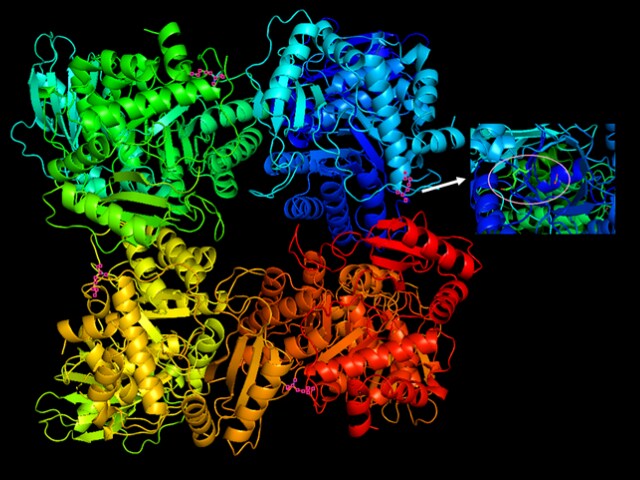RuBisCo Full Form
What is the full form of RuBisCo?
The most prevalent protein in the biosphere is known as RuBisCo or Ribulose Bisphosphate Carboxylase-Oxygenase. It triggers the Calvin cycle's initial step of carbon fixation during photosynthesis. It is the same pathway used by C3, C4, and CAM plants for carbon fixation.
Ribulose bisphosphate (RuBP), the main CO2 acceptor in the C3 pathway or the Calvin cycle, is carboxylated by RuBisCO. In the Calvin cycle, it is the initial stage.
Mesophyll cells in C3 plants and bundle sheath cells in C4 plants both contain RuBisCO. The compound ribulose bisphosphate (RuBP) has five carbons. RuBisCo serves as the Calvin cycle's main carbon dioxide acceptor and is transformed into two molecules of 3-PGA (3-phosphoglyceric acid) by the process.
As implied by its name, RuBisCO has both oxygenase and carboxylase activity. RuBP undergoes a process known as photorespiration in which molecular oxygen serves as the substrate, converting it to one phosphoglycerate and one phosphoglycolate molecule.
Learn more about RuBisCO's structure and enzyme activity below!
RuBisCO Structure and Characteristics
Algae, plants, photosynthetic protists, and some autotrophic bacteria like cyanobacteria and proteobacteria all contain RuBisCO.
The protein RuBisCO is the most prevalent one in the biosphere. In C3 and C4 plants, it makes up about 50% and 30% of all soluble leaf protein, respectively.
Contrary to mesophyll cells in C3 plants, RuBisCO is present in bundle sheath cells in C4 plants.
It is a large, intricate protein composed of both long and short chains. The molecular weight is approximately 540,000 Da.
Typically, there are 8 small chains and 8 large chains, which combine to form 4 dimers. The large chain contains the substrate's active site. Some dinoflagellates and bacteria only have large subunits.
Nuclear DNA codes the small chains, while chloroplast DNA codes the large chain. From the cytoplasm, small chains are imported into the stroma of chloroplasts.
Mg2+ is necessary for the enzyme to function.
Darkness renders RuBisCO inactive; light makes it active.
By attaching CO2 and Mg2+ ions to the lysine residue close to the active site, RuBisCO is activated. This causes conformational changes and stability to the enzyme's active form.

Function of RuBisCo
RuBisCO's primary roles are in photosynthesis and photorespiration.
It catalyses the carboxylation of RuBP, the first stage of carbon fixation in the C3 pathway or Calvin cycle. It results in the formation of two molecules of 3-PGA.
In the process known as photorespiration, RuBisCO also binds to some oxygen because it has an affinity for oxygen. As a result, RuBP is changed into one molecule of each phosphoglycerate and phosphoglycolate.
Photosynthesis is preferred over photorespiration because RuBisCO has a much higher affinity for CO2 than for O2.
Role in Photosynthesis
The Calvin cycle's initial step of carbon fixation is catalysed by RuBisCO. All plants undergo the Calvin cycle, which includes C4, C3, and CAM.
Carboxylation is the Calvin cycle's first stage. Here, CO2 is converted into an organic intermediate that is stable. A 5-C compound is RuBP. It is carboxylated using CO2, and after the C-C bond is broken, two molecules of 3-PGA are produced.
Enolization of RuBP is followed by carboxylation, which creates an intermediary compound called 3-keto-2′-carboxyarabinitol-1,5-bisphosphate. Following hydration, the bond between two carbons is subsequently broken to produce two molecules of 3-phosphoglycerate (3-PGA). The 3-PGA thus produced is used in the subsequent steps to produce glucose and other carbohydrates.
This process takes place in the mesophyll cells of C3 plants. The Clavin cycle takes place in the bundle sheath cells of the C4 pathway. RuBisCO is abundant in the cells of the bundle sheath. This adaptation helps C4 plants reduce photorespiration.
Role in Photorespiration
Additionally preferring oxygen, RuBisCO oxygenates RuBP in the presence of oxygen. Because photorespiration uses ATP, some of the energy from photosynthesis is lost.
RuBP is changed into one molecule of each phosphoglycerate (3C) and phosphoglycolate (2C) when RuBisCO binds to O2.
Considering that it doesn't generate ATP or sugar, the process is wasteful.
Conclusion
This enzyme's full name is ribulose-1,5-bisphosphate carboxylase/oxygenase. RUBISCO catalyses the rate-limiting step in the Calvin-Benson cycle, which changes atmospheric carbon into physiologically usable carbon. Large amounts of Rubisco must be synthesised due to its poor catalytic rate and limited selectivity. We must first comprehend the folding and assembly procedures better in order to construct a Rubisco plant that is more effective. As the name implies, RuBisCO is both an oxygenase and a carboxylase. RuBP is directly converted to one particle of each of phosphoglycerate and phosphoglycolate when molecular oxygen is the substrate. RuBisCO, also known as ribulose bisphosphate Carboxylase-Oxygenase, is the most prevalent protein in the biosphere. It initiates the first phase of the Calvin cycle, which is the process of photosynthesis.It initiates the first phase of the Calvin cycle, which is the process of photosynthesis. It is the primary mechanism used by all plants, including C3, C4, and CAM plants, to fix carbon.
Frequently Asked Questions (FAQs)
Carbon fixation in C3, C4, and CAM plants requires RuBisCO. Mesophyll and bundle sheath cells contain it. It facilitates the Calvin cycle's carbon fixation reaction or the carboxylation of RuBP.
An enzyme called RuBisCO is found in chloroplasts and is used in the dark reaction of photosynthesis.
RuBisCO is active in mesophyll cells of C3 plants, whereas it is present in bundle sheath cells of C4 plants.
Ribulose 1,5-bisphosphate carboxylase-oxygenase is known as RuBisCO. It is in charge of fixing carbon during photosynthesis
Yes, C4 plants do contain RuBisCO. It participates in the Calvin cycle and is found in the bundle sheath cells.
Ribulose bisphosphate Carboxylase-Oxygenase is the full form of the enzyme.